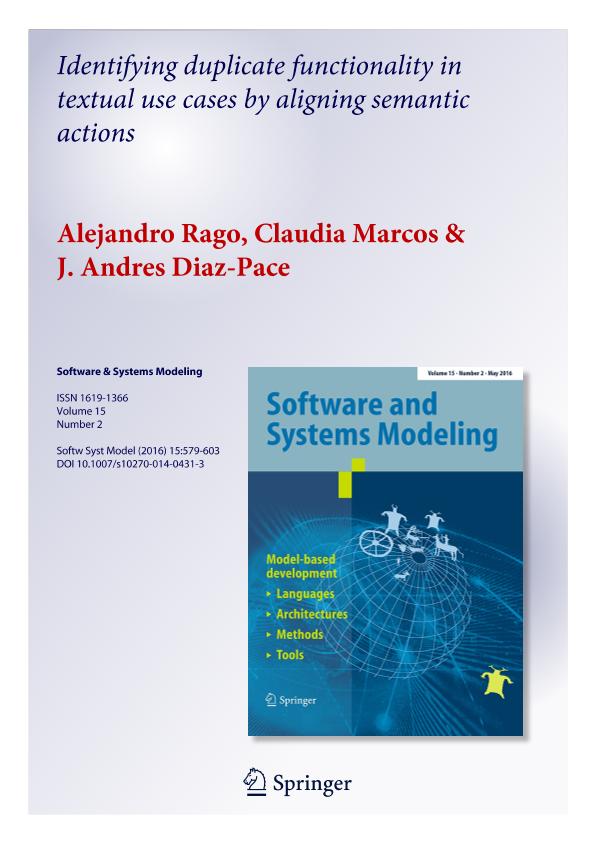Mostrar el registro sencillo del ítem
dc.contributor.author
Rago, Alejandro Miguel

dc.contributor.author
Marcos, Claudia Andrea

dc.contributor.author
Diaz Pace, Jorge Andres

dc.date.available
2018-09-05T19:09:20Z
dc.date.issued
2016-05
dc.identifier.citation
Rago, Alejandro Miguel; Marcos, Claudia Andrea; Diaz Pace, Jorge Andres; Identifying duplicate functionality in textual use cases by aligning semantic actions; Springer Heidelberg; Software and Systems Modeling; 15; 2; 5-2016; 579-603
dc.identifier.issn
1619-1366
dc.identifier.uri
http://hdl.handle.net/11336/58417
dc.description.abstract
Developing high-quality requirements specifications often demands a thoughtful analysis and an adequate level of expertise from analysts. Although requirements modeling techniques provide mechanisms for abstraction and clarity, fostering the reuse of shared functionality (e.g., via UML relationships for use cases), they are seldom employed in practice. A particular quality problem of textual requirements, such as use cases, is that of having duplicate pieces of functionality scattered across the specifications. Duplicate functionality can sometimes improve readability for end users, but hinders development-related tasks such as effort estimation, feature prioritization, and maintenance, among others. Unfortunately, inspecting textual requirements by hand in order to deal with redundant functionality can be an arduous, time-consuming, and error-prone activity for analysts. In this context, we introduce a novel approach called ReqAligner that aids analysts to spot signs of duplication in use cases in an automated fashion. To do so, ReqAligner combines several text processing techniques, such as a use case-aware classifier and a customized algorithm for sequence alignment. Essentially, the classifier converts the use cases into an abstract representation that consists of sequences of semantic actions, and then these sequences are compared pairwise in order to identify action matches, which become possible duplications. We have applied our technique to five real-world specifications, achieving promising results and identifying many sources of duplication in the use cases.
dc.format
application/pdf
dc.language.iso
eng
dc.publisher
Springer Heidelberg

dc.rights
info:eu-repo/semantics/openAccess
dc.rights.uri
https://creativecommons.org/licenses/by-nc-sa/2.5/ar/
dc.subject
Machine Learning
dc.subject
Natural Language Processing
dc.subject
Requirements Engineering
dc.subject
Sequence Alignment
dc.subject
Use Case Modeling
dc.subject
Use Case Refactoring
dc.subject.classification
Ciencias de la Computación

dc.subject.classification
Ciencias de la Computación e Información

dc.subject.classification
CIENCIAS NATURALES Y EXACTAS

dc.title
Identifying duplicate functionality in textual use cases by aligning semantic actions
dc.type
info:eu-repo/semantics/article
dc.type
info:ar-repo/semantics/artículo
dc.type
info:eu-repo/semantics/publishedVersion
dc.date.updated
2018-09-05T15:52:54Z
dc.identifier.eissn
1619-1374
dc.journal.volume
15
dc.journal.number
2
dc.journal.pagination
579-603
dc.journal.pais
Alemania

dc.journal.ciudad
Heidelberg
dc.description.fil
Fil: Rago, Alejandro Miguel. Consejo Nacional de Investigaciones Científicas y Técnicas. Centro Científico Tecnológico Conicet - Tandil. Instituto Superior de Ingeniería del Software. Universidad Nacional del Centro de la Provincia de Buenos Aires. Instituto Superior de Ingeniería del Software; Argentina
dc.description.fil
Fil: Marcos, Claudia Andrea. Universidad Nacional del Centro de la Provincia de Buenos Aires. Facultad de Ciencias Exactas. Instituto de Sistemas Tandil; Argentina
dc.description.fil
Fil: Diaz Pace, Jorge Andres. Consejo Nacional de Investigaciones Científicas y Técnicas. Centro Científico Tecnológico Conicet - Tandil. Instituto Superior de Ingeniería del Software. Universidad Nacional del Centro de la Provincia de Buenos Aires. Instituto Superior de Ingeniería del Software; Argentina
dc.journal.title
Software and Systems Modeling

dc.relation.alternativeid
info:eu-repo/semantics/altIdentifier/doi/http://dx.doi.org/10.1007/s10270-014-0431-3
dc.relation.alternativeid
info:eu-repo/semantics/altIdentifier/url/https://link.springer.com/article/10.1007%2Fs10270-014-0431-3
Archivos asociados
